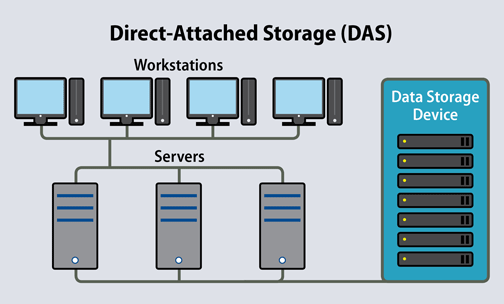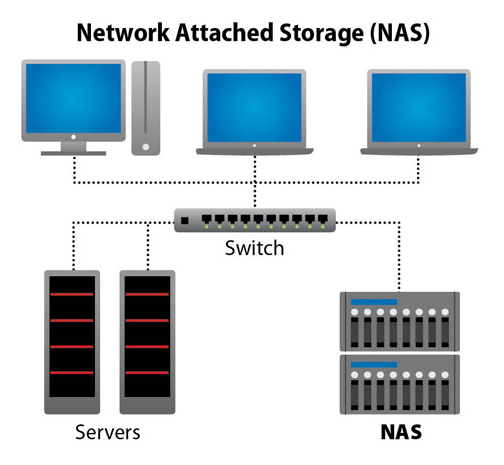What Is RAID Storage
Redundant Array of Independent Disks, or RAID, is a data storage virtualization technology that is used to combine physical drives into one or more logical units for the purposes of performance improvement, storage capacity enlargement, fault tolerance, or all at once. Simply put, it is a way of storing the same data in different places (on multiple solid-state or hard disk drives) to protect the information in the event of a failure. To ensure this, RAID employs techniques known as disk mirroring and disk striping.
The mirroring technique implies that the data is stored twice, being written to both the set of data drives and a set of mirror drives. Striping partitions, in turn, allows to distribute data over multiple disks, where each drive’s storage space is separated into units ranging from a sector (512 bytes) up to several megabytes, interleaved and addressed in order. Finally, there are RAID configurations that combine both of these methods.
Key Criteria to Consider
When investing in RAID storage, a consumer should look for hardware that is a recognized brand with tech support, reliable HDD models, and a low amount of power consumption. However, the first step is to determine which option best suits your needs. Here are some key points to focus on:
• Capacity: How much data do you need to store?
• Accessibility: How often do you need to access the data, and how many employees will require to share it?
• Reliability: Can your business survive without the data? How much may downtime cost your business?
• IT Staff and Resources: Have you got an IT team to manage the system?
• Budget: Finally, how much are you willing to spend on it?
The amount of data you have directly depended on how much storage you need. In most cases, RAID redundancy means that a part of the storage space will be used to keep copies of files, or a portion of what you have written to disks. In turn, the size of the disks used in an array determines the cost, so some configurations may be more expensive than others.
Besides, there are RAIDs designed for archiving, which provide higher dependability rates, but are more difficult to read from and write to, and those built for users who will need to read and write on a regular basis, that is options offering faster performance. Technical reviewers and experts on RAID configurations test various features to measure the quality of the storage systems, including type of internal hardware, read-and-write speeds, and the principle by which the system records and stores data.
Types of Internal RAID Storage
Now, there are three main types of storage technologies used in a RAID, namely Direct Attached Storage, Network Attached Storage, and Storage Attached Network.
Direct Attached Storage (DAS) is a low-cost digital storage system that’s typically made of a data storage device (one or several hard disk drives) which is directly connected to a server or workstation through a host bus adapter, without a network in between. While their ability to grow and scale is limited, meaning it won’t suffice for business applications that require greater flexibility and data-sharing across big teams, DAS solutions are known for the fastest operating speeds compared to either of the other two storage methods, and are a good option to benefit from energy efficiency.

Advantages:
• Storage capacity expansion is possible
• Fast data transfer (speed depends on the interface)
• Plug and Play — no complicated setup is required
• Utilizes OS’s native file system
Disadvantages:
• Data not accessible by diverse user groups
• High administrative costs
BEST FOR: for small businesses that share data locally, and companies which have little to no IT support to maintain a complex system.
Network-Attached Storage (NAS) is a dedicated server that is attached to a network and accessed through an assigned network address. Simply speaking, NAS-based systems are used to facilitate data storage across multiple computers, meaning the information can be accessed from any machine within the network or over the internet.
NAS storage functions like a server for file sharing but doesn’t apply other services — like emails or authentication. It allows more storage space to be added to the available networks, even when the system is shut down during maintenance. In addition, having one centralized shared storage, NAS-based system can also save money in the long run, obviate confusion, and, with features like RAID, increase reliability in the event of a system failure or an outage.
At the same time, working with this system may be quite difficult for enterprises that need to be able to send large amounts of data. Just like a SAN, it uses an Ethernet connection and requires a processor, RAM, and an operating system. It enables RAID redundancy to a mass amount of users, though performance may be affected by network conditions.

Advantages:
• Data can be shared among users and devices
• Data can be accessed by diverse user groups at the same time
• Remote access is possible via Ethernet
• Web applications provide additional functionality independent of the computer
• Storage capacity expansion is possible (depends on NAS function)
Disadvantages:
• Data transfer rates are not as fast as DAS
• Requires at least basic network knowledge
• Network-dependent
BEST FOR: organizations looking for reliable, flexible, minimal-maintenance storage that can compound potential growth and quickly scale up as needed to accommodate new users or growing data.
Storage Area Network (SAN) is a dedicated, high-performance storage system that provides block-level transfer of data between servers and storage devices. It offers file sharing with DAS’s speeds in combination with flexibility and reliability of NAS-based storages. SAN storage is a very sophisticated option designed to support complex, mission-critical business applications and databases. SAN is generally used in big enterprises, data centers, or virtual computing environments.
As a separate network, SAN moves off resources out of the LAN (Local Area Network), creating a separate, high-speed, well-organized environment that can be accessed by every client OS as if it were directly connected storage. More than that, it also provides better redundancy, meaning that, in case one of the servers goes down, the other devices within the same network will pick up the slack. Rather than being made up with a single storage device, SAN-based system is a network of storage devices that work together as a single cluster.

Advantages:
• Ability to store vast amounts of data
• Better redundancy; fault-tolerance
• High performance
• Fast backups that don’t cause bottlenecks (like other storage solutions might)
• Quicker disaster recovery in the event of failure
Disadvantages:
• High complexity; expert installation and setup are required
• High cost; the upfront costs of hardware can be a major deterrent
• Doesn’t work well with only a few servers
BEST FOR: data centers and large-scale enterprises that require block-level data sharing of mission-critical files or applications.
